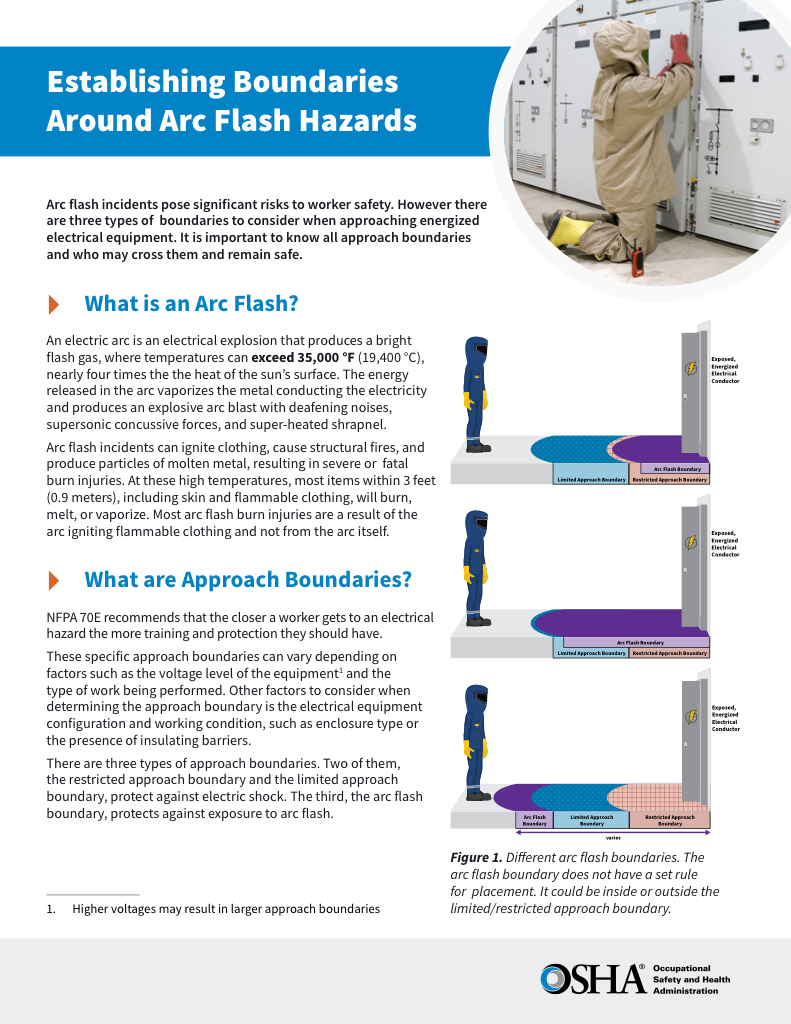General Electrical Safety Procedures

NFPA 70e Training
Our customized live online or in‑person group training can be delivered to your staff at your location.

- Live Online
- 6 hours Instructor-led
- Group Training Available
Download Our OSHA 4474 Fact Sheet – Establishing Boundaries Around Arc Flash Hazards

- Understand the difference between arc flash and electric shock boundaries
- Learn who may cross each boundary and under what conditions
- Apply voltage-based rules for safer approach distances
General electrical safety includes de-energizing circuits, using PPE, applying lockout/tagout, and inspecting equipment. These precautions help prevent arc flash, electric shock, and electrocution in industrial and commercial environments.
General Electrical Safety
-
✅ Definition: Practices that reduce the risk of shock, arc flash, and electrocution.
-
✅ Core Measures: Lockout/tagout, inspections, PPE use.
-
✅ Objective: Ensure worker protection and regulatory compliance.
General electrical safety refers to the essential precautions and best practices that help prevent electrical hazards in homes, workplaces, and industrial settings. From avoiding contact with live wires to understanding circuit overload risks, basic safety measures ensure protection against shocks, fires, and equipment damage. General electrical safety involves understanding and implementing basic electrical safety principles to prevent accidents and injuries. This includes identifying and controlling hazards such as electrical arc flash and other electrical hazards through a comprehensive electrical safety program. Safe use of extension cords, proper installation of ground fault circuit interrupters, and effective management of hazardous energy are essential. Workers must be trained to handle power tools safely, wear appropriate protective equipment, and follow safe work practices to minimize risks and maintain a secure working environment. To deepen your understanding of general energy safety, consider exploring our comprehensive guide on Electrical Safety, which covers essential practices and standards.
The current in an ordinary home or business has enough power to cause death by electrocution. People don't realize that even the changing of a light bulb without first unplugging the lamp or lighting fixture could be hazardous because the "hot" or live part could injure a person if they contact it.
Any system has the potential to injure. Electricity can be either "static" or "dynamic":
Test Your Knowledge About Arc Flash!
Think you know Arc Flash? Take our quick, interactive quiz and test your knowledge in minutes.
- Instantly see your results and score
- Identify strengths and areas for improvement
- Challenge yourself on real-world electrical topics
-
Dynamic electricity is the uniform motion of electrons through a conductor (electric current). Any discussion of safety will be an examination of dynamic electricity
-
Static electricity is accumulation of charge on surfaces as a result of contact and friction with another surface. Electrons accumulate on one surface, creating a deficiency of electrons on the other surface
-
Electric current cannot exist without an unbroken path to and from the conductor
General enegry safety is very important for home owners. It is recommended that all homeowners have their systems inspectded periodically in order to learn of any underlying conditions that may be harmful to their families. Implementing general energy safety measures in healthcare settings is vital; learn more on " target="_blank">Hospital Electrical Safety.
Electrical fires that sometimes occur in the home create personal injuries like burns and loss of personal property and most of these fires are caused by faulty electrical wiring. The two typical types of accidents connected with faulty wiring are mostly caused by: (1) electric shocks and 2) fires. These electric shocks are generally rare but they do occur and a lot of the accidents have been associated with people who have been working on either repairing or modifying equipment. Most accidents seem due to incompetence by the person that is carrying out the work, without any respect for general energy safety.
Common sense should be applied. The circuit should be isolated through a general safety lockout tagout procedure before any repairs are carried out on the equipment. Another test of the energized circuit should be conducted using a proper test meter to determine if the circuit has been fully isolated. These basic general safety measures could prevent any individual from receiving an electric shock, which depending on the conditions could be fatal. For a broader perspective on general safety, our piece on Electricity Safety discusses the dangers of currents and preventive strategies.
Understanding Electricity
Electricity forms a "path" or "loop". When you plug in a device, the electricity takes the easiest path from the plug to the tool, and then back to the power source (plug). This creates or completes an electrical circuit. People are injured when they become part of the circuit. Humans are more conductive than the earth, which means if there is no other easy path, electricity will try to flow through our bodies.
There are four chief kinds of general safety injuries:
-
electrocution (death from electrical shock)
-
electric shock
-
burns; (arc flash injuries)
-
falls after electric shock
These injuries can happen in various ways:
-
Direct contact with the energy. The electricity interferes with the normal signals between the brain and muscles, causing the heart to stop beating properly or breathing to stop, or causing the muscles to go into spasm
-
When the electric current passes through the air to a person who is grounded, the body provides an alternative route to the ground for the electric current
-
Arc flashes create intense heat causing severe burns, flash with an intense light, which can cause blindness and ignite materials
-
Arc blasts cause the same conditions as an arc flash, but are more intense and can also include a strong pressure wave. These pressure waves can damage machinery, throw a person, collapse a lung or rupture eardrums
-
Thermal burns, including flash burns from heat generated by an electric arc and flame burns from materials that catch on fire from heating or ignition by electrical currents. It should be noted that current can burn internal tissues while creating only small injuries on the surface of the skin
-
Muscle contractions (startle reaction) can cause a person to fall from a ladder, aerial bucket or scaffold
General Electrical Safety Practices
It is the employer’s responsibility to inspect on a regular basis all equipment, fittings and installations. This inspection should always be carried out by a person possessing sufficient technical knowledge, experience and skills.
Sign Up for Electricity Forum’s Arc Flash Newsletter
Stay informed with our FREE Arc Flash Newsletter — get the latest news, breakthrough technologies, and expert insights, delivered straight to your inbox.
A general safety risk assessment should be undertaken by the employer where there is the potential for harm to be caused and measures to control risks should be implemented.
An inventory of all equipment, fittings and installations on the site should be drawn up. This should record the serial number or another form of identification.
A general safety inspection should take place at least at the following intervals (and more frequently in areas of high usage or subject to abuse):
-
FIXED INSTALLATIONS: every five years at least
-
TEMPORARY INSTALLATIONS: every three months
-
PORTABLE ELECTRICAL EQUIPMENT: visually each term with a thorough general safety inspection and test each year
Understanding the risks associated with arc flashes is a key component of general electrical safety; our What Is Arc Flash article provides detailed insights into this hazard.
Related Article:








